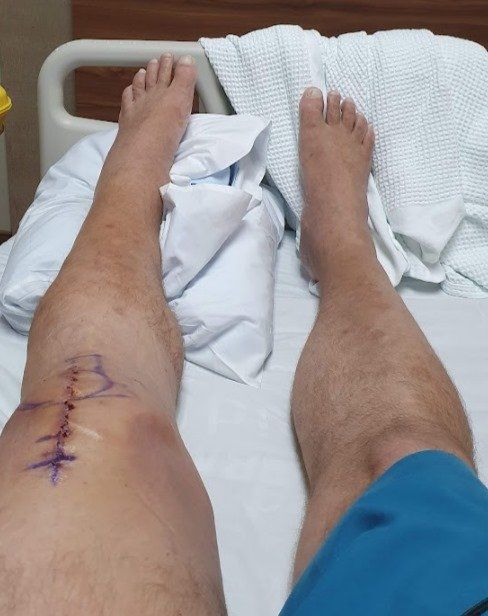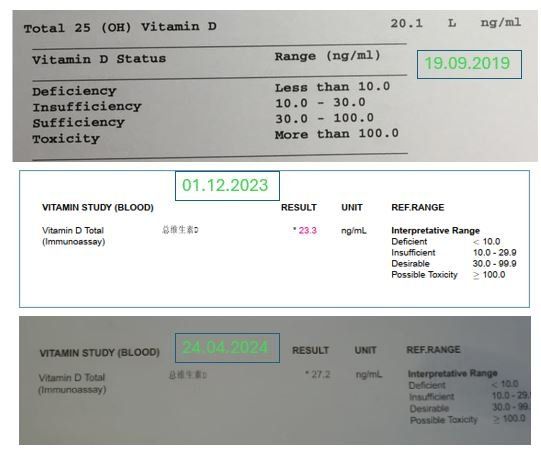Here is where I am coming from: I am regularly checking my blood values, for many years.
Usually, everything is in good order, or at least the measurement values are tolerable.
My latest annual check-up revealed some changes, though. My blood values deteriorated after I had knee surgery after an accident: I stumbled in an unexpected water puddle in our staircase, and I ruptured my left quadriceps tendon.

The surgery went well but that accident left some traces in my general health. Not only was I literally set back to zero with my weights lifting results. I had to cancel my participation at the World Championship 2023. That was followed by a forced almost-no-walking period of 4 months. And this immobile life style messed up my blood measurements. The story about that and about the healing that followed from December 2023 onwards will follow in another article, once I am happy with the results.
During the 4-months long period since December 2023 until April 2024 I went through several blood tests, and I thought that I could try to improve my low Vitamin D levels by walking under the mid-day equator sun in Singapore. That way I could catch two birds with one stone: increase my daily walking distance and catch some UVB radiation.
Here is what a cancer website says:
The best source of vitamin D is UVB radiation from the sun. UV radiation levels vary depending on location, time of year, time of day, cloud coverage and the environment. For most people, adequate vitamin D levels are reached through regular incidental exposure to the sun.
And when I read up on how put that advice to practice, there are comments that say. "Well, not everybody lives at the equator, and that is where it works best."
Why Walking in the Hot Mid-Day Equator Sun
The angle of the sun above the horizon is called the "solar elevation angle." This angle is very important for making vitamin D in your skin when it is exposed to sunlight. This process largely depends on UVB rays from the sun. These rays are affected by the sun's angle. A lower sun angle means the sunlight travels longer through the atmosphere. This longer distance filters out most of the UVB rays but leaves UVA rays. So, even if the sun is low and you can still tan, your body does not make vitamin D.
Time of Day: The sun's rays are strongest and most direct around solar noon, which is when the sun is highest in the sky. At this time, UVB rays are more intense, which boosts the skin's ability to make vitamin D.
Season: In winter, especially far from the equator, the sun's angle is lower. This lower angle leads to fewer UVB rays reaching the earth, which decreases the skin's ability to make vitamin D. In summer, the higher sun angle allows more UVB rays to reach us, enhancing vitamin D production.
Latitude: The closer you are to the equator, the higher the sun's angle throughout the year, which leads to more consistent vitamin D production. As you move towards the poles, the sun's angle drops, especially in winter, making it harder to produce vitamin D.
Time of Year: The sun's angle changes throughout the day and also over the year. This change affects how much UVB light gets through the atmosphere to your skin.
For the best vitamin D production, it is recommended to expose your skin to sunlight when the sun is more than a 30-degree angle above the horizon. This typically happens between 10 AM and 3 PM, depending on where you live and the time of year.
Now I live in Singapore which is only 111km away from the equator. That should help.
Sun Protection Prevents Vitamin D from Being Produced
Your skin cannot make vitamin D if you use sun protection.
Sunscreen blocks UVB rays completely and stops vitamin D production. For example, sunscreen with an SPF of 30 cuts the skin's ability to make vitamin D by 95%. The higher the SPF, the more it reduces vitamin D synthesis.
Here Comes The Experiment
So I set up a program for doing so: every day at about 12:30, I went for 45 minutes walk, without a hat, with naked arms and legs, wearing a T-shirt and shorts.
And after 21 days, I measured my Vitamin D levels, comparing them with my Vitamin D levels of the years before.
And here is the result:

In very short words, yes, the Vitamin D levels went up a bit because of that daily sunshine walking exercise, but not much. I would have expected that the increase would be more significant and not only 20%, or 4 ng/ml in absolute terms. I would have expected a 100% raise from 23.3 ng/mL to 50 ng/mL or so.
I could now double the radiation dose from 45 minutes per day to 1.5 hours per day, but that comes with an increased skin cancer risk. Another way to double the radiation dose would be to walk with a fully naked upper body, but that is not acceptable in a city like Singapore, not even at the beach. And doing both, doubling the radiation dose from 45 minutes per day to 1.5 hours per day AND to walk with a fully naked upper body would only get me to about 40 ng/mL, which is just at the lower threshold of the acceptable Vitamin D levels. And it would cost me 1.5 hours of my life, on a daily basis.
Eating 1.5 to 3kg salmon per day probably would achieve the same thing, but that is also not realistic.
Conclusion
Walking outside to sufficiently increase your Vitamin D levels is not a viable solution.
This is why I have started to take a Vitamin D-3 supplement, and I take 20,000 IUs per day.
I will report about the result of my efforts in about 2 months' time.
Originally published 05 May 2024
The content of this article is intended to provide a general guide to the subject matter. Specialist advice should be sought about your specific circumstances.

